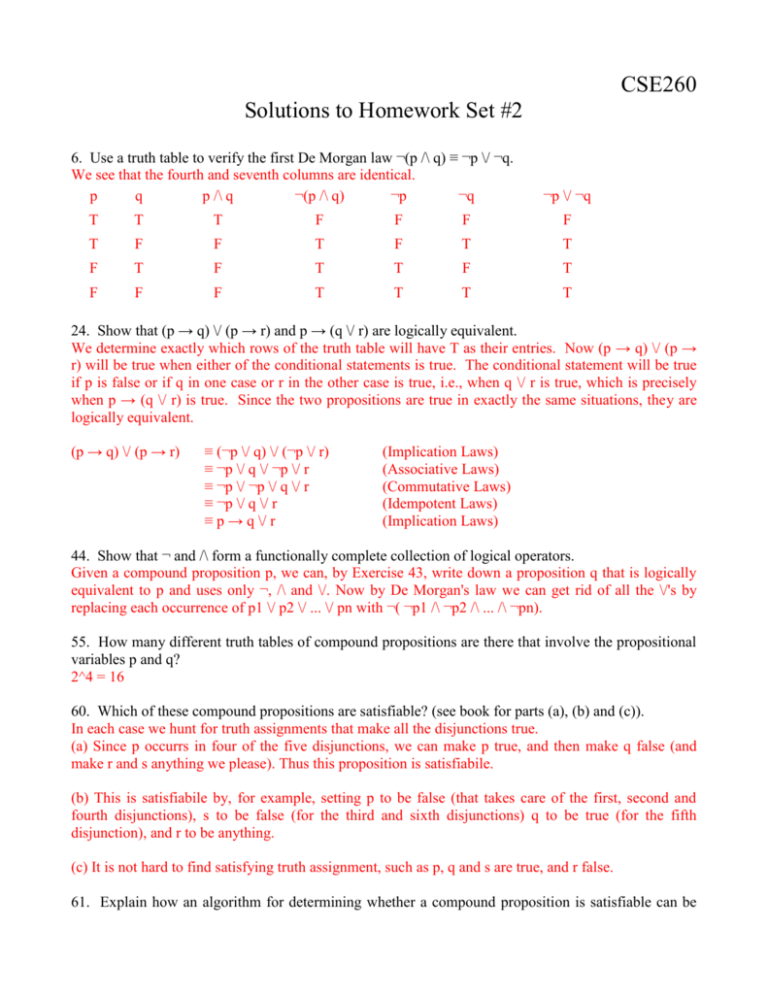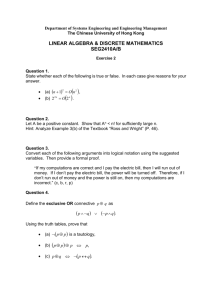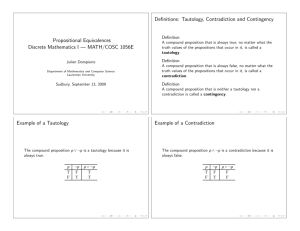Homework 2: Answer
advertisement

CSE260
Solutions to Homework Set #2
6. Use a truth table to verify the first De Morgan law ¬(p /\ q) ≡ ¬p \/ ¬q.
We see that the fourth and seventh columns are identical.
p
q
p /\ q
¬(p /\ q)
¬p
¬q
¬p \/ ¬q
T
T
T
F
F
F
F
T
F
F
T
F
T
T
F
T
F
T
T
F
T
F
F
F
T
T
T
T
24. Show that (p → q) \/ (p → r) and p → (q \/ r) are logically equivalent.
We determine exactly which rows of the truth table will have T as their entries. Now (p → q) \/ (p →
r) will be true when either of the conditional statements is true. The conditional statement will be true
if p is false or if q in one case or r in the other case is true, i.e., when q \/ r is true, which is precisely
when p → (q \/ r) is true. Since the two propositions are true in exactly the same situations, they are
logically equivalent.
(p → q) \/ (p → r)
≡ (¬p \/ q) \/ (¬p \/ r)
≡ ¬p \/ q \/ ¬p \/ r
≡ ¬p \/ ¬p \/ q \/ r
≡ ¬p \/ q \/ r
≡ p → q \/ r
(Implication Laws)
(Associative Laws)
(Commutative Laws)
(Idempotent Laws)
(Implication Laws)
44. Show that ¬ and /\ form a functionally complete collection of logical operators.
Given a compound proposition p, we can, by Exercise 43, write down a proposition q that is logically
equivalent to p and uses only ¬, /\ and \/. Now by De Morgan's law we can get rid of all the \/'s by
replacing each occurrence of p1 \/ p2 \/ ... \/ pn with ¬( ¬p1 /\ ¬p2 /\ ... /\ ¬pn).
55. How many different truth tables of compound propositions are there that involve the propositional
variables p and q?
2^4 = 16
60. Which of these compound propositions are satisfiable? (see book for parts (a), (b) and (c)).
In each case we hunt for truth assignments that make all the disjunctions true.
(a) Since p occurrs in four of the five disjunctions, we can make p true, and then make q false (and
make r and s anything we please). Thus this proposition is satisfiabile.
(b) This is satisfiabile by, for example, setting p to be false (that takes care of the first, second and
fourth disjunctions), s to be false (for the third and sixth disjunctions) q to be true (for the fifth
disjunction), and r to be anything.
(c) It is not hard to find satisfying truth assignment, such as p, q and s are true, and r false.
61. Explain how an algorithm for determining whether a compound proposition is satisfiable can be
used to determine whether a compound proposition is a tautology.
To determine whether c is a tautology apply an algorithm for satisfiability to ¬c. If the algorithm says
that ¬c is satisfiable, then we report that c is not a tautology, and if the algorithm says that ¬c is not
satisfiable, then we report that c is a tautology.
1a. Construct the truth table for the following compound proposition and then construct the disjunctive
normal form for the compound proposition.
(p \/ q) → ¬(p \/ r).
p
q
r
p \/ q
p \/ r
¬(p \/ r)
(p \/ q) → ¬(p \/ r)
T
T
T
T
T
F
F
T
T
F
T
T
F
F
T
F
T
T
T
F
F
T
F
F
T
T
F
F
F
T
T
T
T
F
F
F
T
F
T
F
T
T
F
F
T
F
T
F
T
F
F
F
F
F
T
T
(¬p /\ q /\ ¬r) \/ (¬p /\ ¬q /\ r) \/ (¬p /\ ¬q /\ ¬r)
1b. A collection of logical operators is called functionally complete if every compound proposition is
logically equivalent to a compound proposition involving only these logical operators. Show that (¬,
\/) form a functionally complete collection of logical operators.
Disjunctive normal form uses only ¬, /\, and \/, and is functionally complete. Using De Morgan's
Laws, we can eliminate all the /\ or all the \/ in any proposition. Thus {¬, /\} and {¬, \/} are
functionally complete.
1c. Give the propositional functions s(x,y) and c(x,y) in disjunctive normal form.
Each line of the truth table corresponds to exactly one combination of truth values for the n atomic
propositions involved. We can write down a conjunction that is true precisely in this case, namely the
conjunction of all the atomic propositions that are true and the negations of all the atomic propositions
that are false. If we do this for each line of the truth table for which the value of the compound
proposition is to be true, and take the disjunction of the resulting propositions, then we the desired
proposition in its disjunctive normal form.
for s(x,y) consider the rows 2 and 3, (x /\ ¬y) \/ (¬x /\ y).
c(x,y) we need to consider only the first row, x /\ y.











